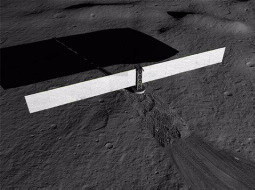EMBARGOED FOR RELEASE | August 28, 2011
The first nuclear power plants for settlements on the Moon & Mars
Note to journalists: Please report that this research was presented at a meeting of the American Chemical Society.
DENVER, Aug. 28, 2011 — The first nuclear power plant being considered for production of electricity for manned or unmanned bases on the Moon, Mars and other planets may really look like it came from outer space, according to a leader of the project who spoke here today at the 242nd National Meeting & Exposition of the American Chemical Society (ACS).
James E. Werner said that innovative fission technology for surface power applications is far different from the familiar terrestrial nuclear power stations, which sprawl over huge tracts of land and have large structures such as cooling towers.
“People would never recognize the fission power system as a nuclear power reactor,” said Werner. “The reactor itself may be about 1 ½ feet wide by 2 ½ feet high, about the size of a carry-on suitcase. There are no cooling towers. A fission power system is a compact, reliable, safe system that may be critical to the establishment of outposts or habitats on other planets. Fission power technology can be applied on Earth’s Moon, on Mars, or wherever NASA sees the need for continuous power.”
Media Contact
During the meeting, Aug. 25-Sept. 1, the contacts can be reached at: 303-228-8532
Michael Bernstein
202-872-6042
m_bernstein@acs.org
Michael Woods
202-872-6293
m_woods@acs.org
The team is scheduled to build a technology demonstration unit in 2012. This is a cooperative project between the National Aeronautics and Space Administration (NASA) and the U.S. Department of Energy (DOE). Werner leads the DOE’s Idaho National Laboratory involvement in this effort, which includes participation in the reactor design and modeling teams, fuel development and fabrication and development of a small electrical pump for the liquid metal cooled system.
Sunlight and fuel cells were the mainstays for generating electricity for space missions in the past, but engineers realized that solar energy has limitations. Solar cells do a great job supplying electricity in near-Earth orbits and for satellite-borne equipment, but nuclear power offers some unique capabilities that could support manned outposts on other planets or moons.
“The biggest difference between solar and nuclear reactors is that nuclear reactors can produce power in any environment,” Werner explained. “Fission power technology doesn’t rely on sunlight, making it able to produce large, steady amounts of power at night or in harsh environments like those found on the Moon or Mars. A fission power system on the Moon could generate 40 kilowatts or more of electric power, approximately the same amount of energy needed to power eight houses on Earth.” In addition, he said that a fission power system could operate in a variety of locations such as in craters, canyons or caves.
“The main point is that nuclear power has the ability to provide a power-rich environment to the astronauts or science packages anywhere in our solar system and that this technology is mature, affordable and safe to use,” Werner said.
Fission power systems rely on energy generated from nuclear fission. Nuclear fission works by splitting uranium atoms to generate heat that is then converted into electric power. The primary components of a fission power system are similar to those found in the commercial reactors currently in use: a heat source, power conversion, heat rejection and power conditioning and distribution.
Werner added that despite the similarities in components, fission power systems for space applications feature a number of differences compared with commercial reactors.
“While the physics are the same, the low power levels, control of the reactor and the material used for neutron reflection back into the core are completely different,” Werner said. “Weight is also a significant factor that must be minimized in a space reactor that is not considered in a commercial reactor.”
Werner contends that once the technology is developed and validated, it may prove to be one of the most affordable and versatile options for providing long-term base power for the space exploration programs.
###



